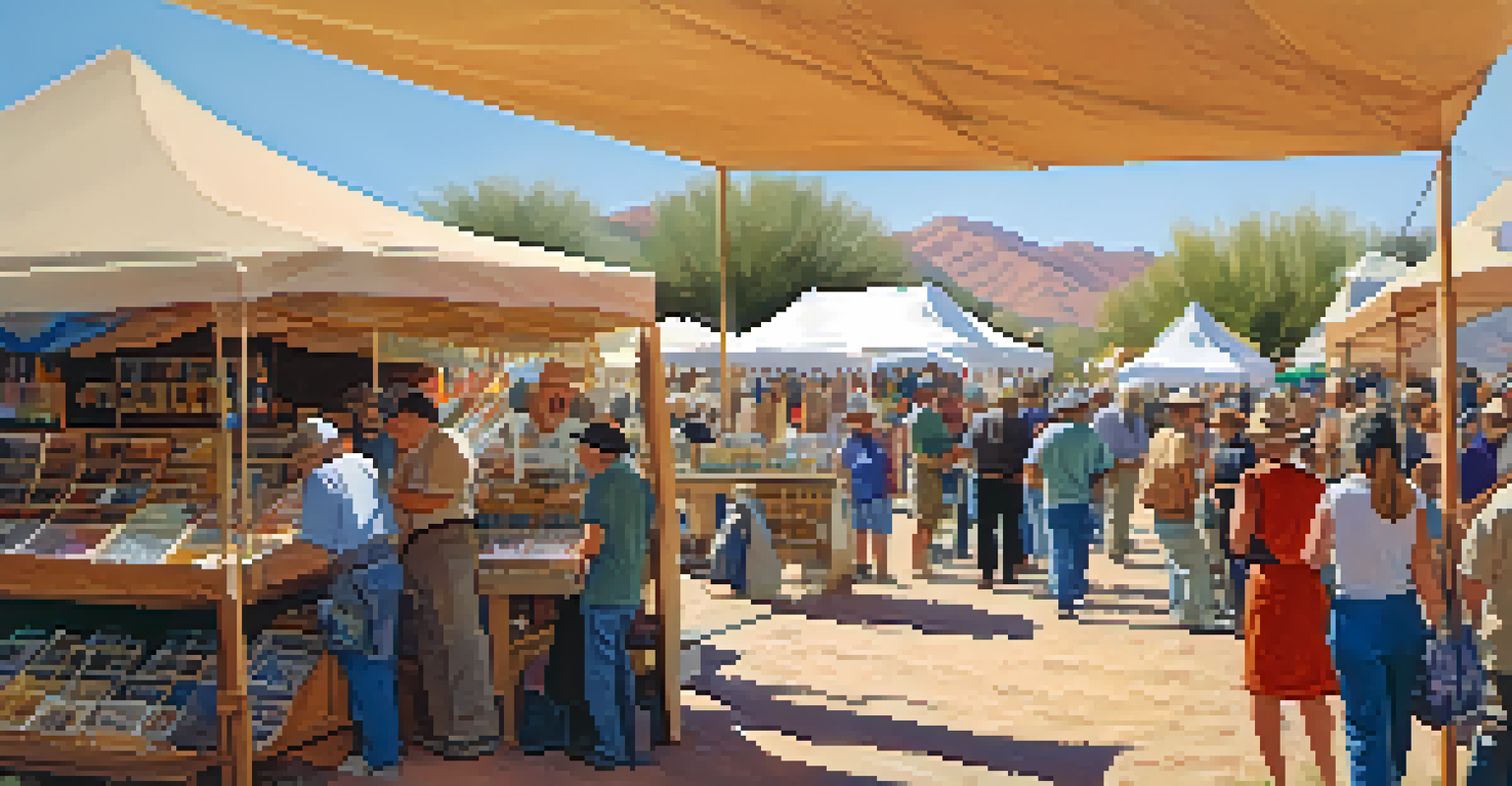The Role of Tourism in Arizona's Economic Development

The Importance of Tourism in Arizona's Economy
Tourism is a cornerstone of Arizona's economy, contributing significantly to job creation and state revenue. With its stunning landscapes and rich cultural heritage, Arizona attracts millions of visitors each year. This influx not only supports local businesses but also stimulates various sectors, from hospitality to retail.
Tourism is an economic driver that creates jobs and bolsters local economies, making it a vital component of growth for communities.
In 2022 alone, tourism in Arizona generated approximately $23 billion in spending, showcasing its critical role in economic development. This spending helps fund essential services, such as education and infrastructure, benefiting local communities as a whole. Moreover, the tourism industry creates jobs, providing employment opportunities for a diverse workforce.
As a result, the economic ripple effect of tourism extends beyond direct spending. With each visitor, there's an increase in demand for services like transportation, dining, and entertainment, further enhancing job opportunities across the state. This cycle emphasizes how tourism fuels Arizona's economic engine.
Key Attractions Driving Tourism Growth
Arizona is home to iconic attractions like the Grand Canyon, Sedona's red rocks, and the vibrant city of Phoenix. These destinations draw tourists not just from across the U.S., but from around the globe, eager to experience the natural beauty and cultural richness of the state. The unique landscapes and historical sites offer countless opportunities for adventure and exploration.

In addition to natural wonders, Arizona hosts numerous festivals and events that celebrate its diverse culture. Events like the Tucson Gem and Mineral Show and the Phoenix Open attract large crowds, boosting local economies during their peak seasons. Such attractions not only enrich the visitor experience but also provide significant boosts to surrounding businesses.
Tourism Drives Arizona's Economy
Tourism significantly boosts Arizona's economy, generating billions in spending and creating jobs across various sectors.
Furthermore, the state has invested in marketing campaigns to promote lesser-known attractions, which helps distribute tourist dollars more evenly. By highlighting these hidden gems, Arizona can enhance tourism growth and ensure its economic benefits reach a wider range of communities.
The Job Creation Impact of Tourism
The tourism sector plays a vital role in job creation throughout Arizona. From hotel staff to tour guides, the industry provides employment opportunities for a wide range of skill levels. The jobs created by tourism are essential, especially in rural areas where other employment options may be limited.
Sustainable tourism is not just a trend; it is the future of travel, ensuring that our beautiful destinations remain intact for generations to come.
Many of these positions are entry-level, making them accessible to young people entering the workforce. This accessibility helps to foster a culture of service and hospitality that is unique to Arizona. Additionally, as employees gain experience, they can advance within the industry, further contributing to local economic stability.
Moreover, tourism-related jobs often have a multiplier effect, as employees spend their wages in the local economy. This spending supports additional jobs in sectors like retail and services, creating a robust employment landscape. Ultimately, the job creation aspect of tourism is a powerful driver of economic development in Arizona.
Economic Benefits Beyond Job Creation
Tourism in Arizona generates significant tax revenue, which is crucial for funding public services. The taxes collected from visitors help support essential community programs, such as schools and public safety. This financial support is particularly vital in areas where tourism is a primary economic driver.
Moreover, the revenue generated from tourism can be reinvested into infrastructure improvements, enhancing the overall quality of life for residents. Upgraded roads, public transportation, and recreational facilities benefit both tourists and locals alike. Such investments can lead to a more attractive environment for future visitors and potential new residents.
Job Creation Through Tourism
The tourism industry provides diverse employment opportunities, particularly in rural areas, benefiting the local workforce and economy.
Additionally, the growth in tourism encourages local governments to support sustainable practices. By promoting eco-tourism and responsible travel, Arizona aims to protect its natural landscapes while still reaping economic benefits. This strategic approach helps ensure that the state can continue to thrive economically while preserving its unique environment.
The Role of Technology in Enhancing Tourism
Technology plays a significant role in shaping tourism in Arizona, making travel planning easier and more efficient for visitors. From online booking platforms to interactive maps, technology has transformed how tourists explore the state. These advancements help attract a tech-savvy generation of travelers who value convenience.
Additionally, social media platforms have become powerful tools for promoting Arizona's attractions. Engaging visual content shared by travelers can reach vast audiences, inspiring others to visit. This organic promotion not only increases awareness but also drives demand for unique experiences across the state.
Moreover, technology facilitates better communication between businesses and tourists, enhancing customer service. Mobile apps allow visitors to access information about local attractions, dining options, and events in real-time. This instant access can significantly enhance the overall visitor experience, encouraging repeat visits and positive word-of-mouth.
Challenges Facing Arizona's Tourism Industry
While tourism brings many benefits to Arizona, it also faces several challenges that must be addressed. Seasonal fluctuations in visitor numbers can strain resources and impact local businesses. During peak seasons, communities may struggle to accommodate the influx of tourists, leading to overcrowding and potential service issues.
Additionally, issues like environmental sustainability are increasingly important in the tourism conversation. As more visitors flock to natural attractions, the risk of environmental degradation rises. Ensuring that tourism growth does not come at the expense of Arizona's beautiful landscapes is crucial for the long-term health of the industry.
Sustainability in Future Tourism
The future of Arizona's tourism will focus on sustainability and experiential travel, addressing environmental concerns while enhancing visitor experiences.
Furthermore, the ongoing impact of global events, such as pandemics or economic downturns, can severely affect travel patterns. Arizona's tourism sector must remain adaptable and resilient to navigate these uncertainties. Developing strategies to diversify the tourism offerings can help mitigate risks and sustain growth in the face of challenges.
Future Trends in Arizona's Tourism Landscape
As we look to the future, several trends are likely to shape Arizona's tourism landscape. One significant trend is the growing demand for experiential travel, where visitors seek authentic, immersive experiences. Arizona's rich cultural heritage and diverse landscapes provide ample opportunities for travelers to engage meaningfully with the destination.
Sustainability will also play a critical role in the future of Arizona tourism. Tourists are becoming increasingly conscious of their environmental impact, prompting businesses to adopt greener practices. This shift not only meets consumer demand but also protects the state's natural resources for future generations.

Finally, technology will continue to influence tourism trends, from virtual reality experiences to enhanced data analytics. These innovations will help businesses better understand traveler preferences, leading to more personalized offerings. As these trends unfold, Arizona's tourism industry will need to remain agile to adapt and thrive in a changing environment.